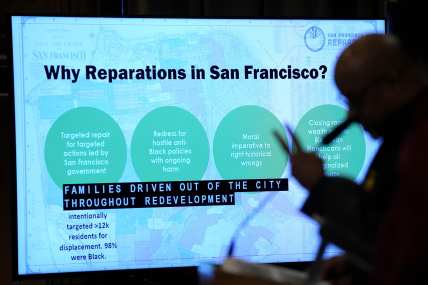The racial wealth gap isn’t closing any time soon
In some parts of the country, it takes the income of two Black households to equal that of one white home, according to Pew Research’s "Facts About the U.S. Black Population" report.
Black families have an annual median household income of $46,400, an astounding 42 percent less than the overall population’s $70,784, according to Pew Research’s “Facts About the U.S. Black Population” report, released earlier this month.
Look at it this way: The difference in median income — $24,384 a year or just about $469 a week — is more than the median income for a household in the poor, mostly Black zip code 35203 in Birmingham, Alabama, where the median income is just $18,894. In other words, it often takes the income of two Black households to equal that of one white home.
Surveys that examine the Black population and its state in America come out fairly regularly. New numbers reinforce that the racial wealth gap remains the biggest impediment for Black people to live today and save for tomorrow.

Those numbers paint the same picture of a promise of equality that seems so far off. The minority population continues to grow, but societal impediments get in the way of real progress for much of the country’s 47.2 million Black people, which accounts for 14.3 percent of the population.
The numbers show an income and wealth gap that makes it difficult for Black families to attain any sort of financial independence and keeps them economically well behind most of the country. Sometimes, making ends meet seems as likely as winning the lottery.
The Brookings Institute, in its 2020 study, examined the Black-white wealth gap, and noted: “Wealth is a safety net that keeps a life from being derailed by temporary setbacks and the loss of income. This safety net allows people to take career risks knowing that they have a buffer when success is not immediately achieved.”
Most Black people aren’t close to being there.
That difference in median income — equal to a full-time job — means Black people have less capacity to save money to build wealth. Forget about wealth; if they have an unforeseen major expense — a house or car repair — they have to often choose between what they will and won’t pay.
Pew dug deeper and found a tremendous disparity within the Black population. Nearly two in 10 people surveyed say they don’t have enough money to meet basic needs, and four of 10 say they have just enough, painting a portrait that reinforces a picture of economic instability. Just 36 percent say they have enough saved to cover three months of expenses, well under the 54 percent of Americans who say they have such a rainy-day fund.
That income difference helps contribute to roughly one in four Black households being late in paying their debts, even though they have less debt than white households. It’s hard to pay a debt of any kind when income lags.
Let’s not forget the long-term consequences. Little money now means less of a chance to prepare for the future, more critical than ever since most U.S. companies no longer offer pensions to employees. More than half of Black households have no savings. Those lucky enough to put aside a little money have a median retirement savings of $29,200, nearly 88 percent less than the median for white families, which is $79,000, according to Investopedia.
The lack of cash also means it’s harder to buy a home because lower-income families don’t possess strong enough credit to qualify for a loan.

“We don’t really have pensions anymore,” Kyle Moore, an economist with the Economic Policy Institute’s Program on Race, Ethnicity and the Economy, previously told theGrio. In discussing how higher interest rates disproportionately affect prospective Black home buyers, Moore said, “401k’s are so risky. The stock market is risky. Homeownership has been that consistent, reliable method of building wealth.”
As in all parts of the country, upper-income Black respondents report weathering a financial crisis much better than those in lower-income brackets. But even that’s misleading. An estimated 11.4 percent of Black families have an annual household income of $100,000 to $149,900 — less, on a percentage basis, than any other demographic group.
So the numbers show that Black people remain behind, but the more important context highlights the devastating life effects of an unequal financial footing.
TheGrio is FREE on your TV via Apple TV, Amazon Fire, Roku and Android TV. Also, please download theGrio mobile apps today!

